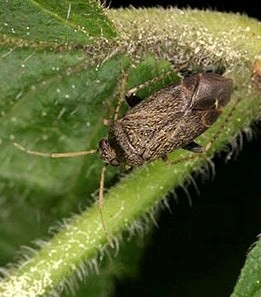Keeled grass bug
(Acetropis carinata)

Description
Keeled grass bug (Acetropis carinata) is a bug in the family Miridae. The species was first scientifically described by Gottlieb August Wilhelm Herrich-Schäffer in 1841. In the Netherlands, the species occurs on sandy soils with the exception of coastal areas. Furthermore, the bug lives in the Palearctic region, North Africa and Asia. Grass bugs are usually greenish or straw colored and elongated in shape so that they do not stand out in the grass between which they live. The keeled grass bug is light green to light brown and wider in the middle than most other grass bugs. The males are 6.5 to 7 mm long and macropterous (long-winged). The females are usually brachypterous(short-winged) and often slightly smaller, 5.5 to 7 mm. The first and second segments of the hairless antennae are light brown and the last two are dark brown. The second segment is as long as the third and fourth segments combined. The pronotum has a longitudinal elevation, also called a keel, and light broad stripes along the side that extend over the wings. Dark stripes run over the eyes and head, continuing over the pronotum and scutellum. The legs are not hairy. This makes the bug different from the otherwise very similar Acetropis gimmerthalii, which does have hairy legs and antennae, but also no clear keel and a different stripe pattern on the pronotum. The species hibernates as an egg, the adults are found from May to August in sandy, dry patches on grasses such as bristle grass, bunt grass, crooked smee and dravik. The males do not live long. Acetropis is a genus of true bugs.
Taxonomic tree:







